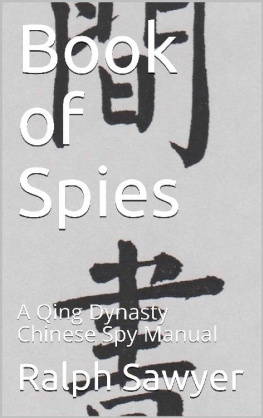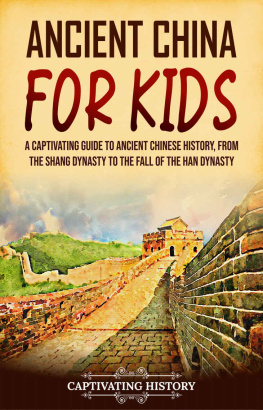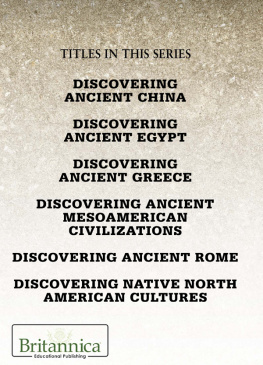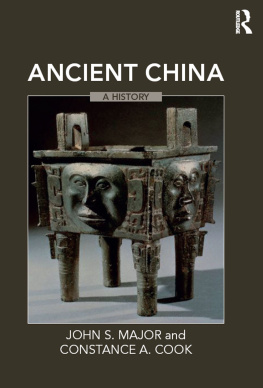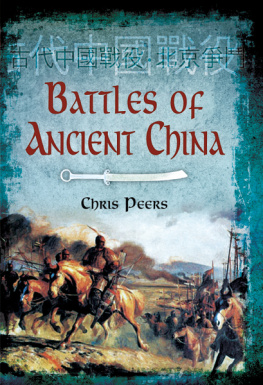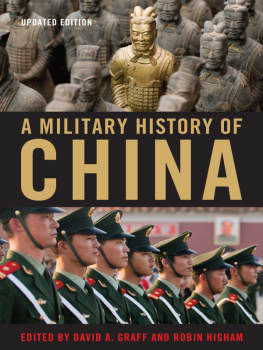Table of Contents
FOR
LEE MEI-CHN
PREFACE
ANCIENT CHINESE WARFARE AND ITS COMPANION, Western Chou Warfare, were started more than thirty years ago but were soon de-emphasized, though never abandoned, to investigate more accessible topics because insufficient archaeological material was available for assessing many aspects of ancient Chinese military history. Even though dramatic new finds such as San-hsing-tui (Sanxingdui) can still provoke astonishment and significantly affect historical understanding, the accumulation of thousands of discoveries and hundreds of highly relevant reports over the intervening decades has not only resulted in something akin to a minimal critical mass, but also considerably diminished the impact of archaeologys accidental nature. To cite just one example, reports on Wangcheng-kang in the early 1980s indicated the existence of a fortress consisting of two small but conjoined square citadels roughly 100 meters on a side that immediately prompted heated arguments about its possible identity as an ancient Hsia (Xia) capital. However, a partial excavation of the greater site in the early twenty-first century has now revealed that the Kings City once enclosed a massive 300,000 square meters within its substantial outer fortifications, considerably buttressing claims for an imperial role.
Although my efforts over the last few years, whether in the cold of Korean winters or heat of interminable Indonesian summers, have been focused on this volume, many more could easily be spent. No one has ever been granted indefinite longevity, yet it is difficult to escape the persistent feeling that only now, after nearly a half century of pondering Chinese topics, am I approaching some requisite level of understanding upon which the entire topic should be restudied. This is particularly true with respect to the ancient period because of the inescapable necessity of relying on innumerable interpretive archaeological reports and scholarly explications of oracular and bronze inscriptional materials, the core of this book.
Despite the convenience of the Internet and the growth of extensive (but not yet fully accessible or comprehensive) databases, exhaustive examination of all relevant articles on any single aspect of ancient Chinese military history, even something as focused as arrowheads, remains impossible. Paradoxically, numerous materials that were once relatively available through interlibrary loan, especially Japanese books and articles, have become even more difficult to acquire due to declining library holdings, an unwillingness to relinquish physical possession, and insufficient staff to provide the photocopies previously enjoyed. Nevertheless, despite the elusiveness of a few known titles and no doubt ignorance of many more, articles through the end of 2008 from the major Chinese historical and archaeological journals, as well as numerous minor ones assembled in collated volumes over the past few decades, and various books and site reports published in the last half century or more provide the basis for this study.
Now that belief in objective history has been discarded, it need hardly be mentioned that all works of this type are necessarily highly individualized creations that are guided by particular views and interpretations, however eclectic. Thus, for example, although increased coverage of Northern zone knives might well be merited, their study has been foregone for examinations of more focal or directly relevant topics such as the role of the yeh (large battle-axe) in solidifying and apportioning martial authority. Selectivity has been particularly severe in the area of contextual history despite the temptation to pursue many threads of Hungshan, Liang-chu, and other cultural ascensions with military implications or to examine the fortifications at a number of additional sites. Fortunately The Cambridge History of Ancient China, despite being silent on the Neolithic and earlier periods, provides extensive background and analysis that may be taken as fundamental, even though I sometimes disagree with their exposition and conclusions, just as I have never assumed that the latest scholarship, no matter how enthusiastically embraced by the scholarly community, necessarily represents an advance or correctness.
A number of minor issues and decisions might well be noted. To take the last first, the concluding chapter, Musings and Imponderables, although somewhat of a summation, rather than striving for an unattainable conclusion, is intended to raise basic questions and indicate significant topics, a few of which will reappear in a future study. The Shangs extinction, being more a tale of conquest than simple collapse, is similarly deferred to the next volume on the rise and dominance of the Chou.
The discussion essentially proceeds in two streams, the textual narrative and a collateral expansion of many aspects and subtopics in the endnotes where matters of purely Sinological import and more general points of military history are explored. To ensure that Ancient Chinese Warfare, which is intended for the broadest possible audience of interested readers rather than just Sinologists, would not only be accessible but also published at a reasonable price rather than an exorbitant one appropriate to a research tome, certain decisions were made that will no doubt be bemoaned by reviewers.
As originally conceived, Ancient Chinese Warfare was to have a number of maps, many of them quite basic, for the convenience of the reader. However, this volume is little concerned with campaigns, obviating any need for phase and tactical depictions, and superior multicolor historical and topographical maps are available on the Internet, making the time and expense of producing them unnecessary. Similarly, many more illustrations of ancient weapons were originally planned, but preliminary readers found them less useful than the relatively few generic versions now included, a fortuitous development since requests made to various archaeological museums and publications in China for permission to reproduce many interesting specimens (and maps) were, on the whole, never even acknowledged.
In part to minimize cost and because it was felt that entries in Chinese characters would be more useful to those with competence in the language, no effort has been made to provide a bibliography of Romanized titles for Chinese and Japanese books and articles. A highly compressed form of reference has also been employed in the endnotes, though shortened titles appear when an author has two or more publications in a single year or similarly titled papers. Rather than encompassing hundreds of books of contextual importance or even the many archaeological reports that individually describe one or two weapons, the expanded basis of this study, the bibliography is also confined to works cited in the endnotes. However, additional titles will appear in subsequent publications, and if interest merits, a complete bibliography of both Western and Chinese works will be made available on Sinostrategist.org.
As in our previous works, although I am responsible for the historical content, writing, military texts, theorizing, and conclusions, Mei-chn has contributed immeasurably to this volume through her management of the vast hoard of research materials underlying this work and the preparation of the bibliography. In addition, because she has willingly, if not always enthusiastically, suffered the tedium of many military discussions, contributed valuable insights, and tramped around the world prowling ancient fortifications, investigating military museums, and attending military conferences while continuing to participate in our ongoing intelligence and corporate consulting, I take great pleasure in dedicating this book to her.


